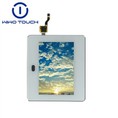Hey there! As an I2C touch screen supplier, I'm super excited to dive into the world of touch panel technologies used in I2C touch screens. So, let's get right into it!
First off, what's I2C? Well, I2C stands for Inter - Integrated Circuit. It's a serial communication protocol that's widely used in electronic devices. It allows multiple devices to communicate with each other on the same bus, which is pretty handy when it comes to touch screens.
Now, let's talk about the different touch panel technologies that can be used in I2C touch screens.
Resistive Touch Panel Technology
Resistive touch panels are one of the oldest and most well - known touch panel technologies. They work by having two conductive layers separated by a small gap. When you press on the screen, the two layers come into contact at that point, and the change in electrical resistance is detected.
The advantage of resistive touch panels is that they can be operated with almost anything, like a finger, a stylus, or even a gloved hand. This makes them really versatile. They're also relatively inexpensive to produce, which is great for cost - sensitive applications.
However, they do have some drawbacks. The outer layer can get scratched easily, which might affect the touch sensitivity over time. Also, they typically have lower clarity compared to some other technologies because of the multiple layers involved.
Capacitive Touch Panel Technology
Capacitive touch panels are super popular these days, especially in smartphones and tablets. They work based on the electrical properties of the human body. The screen has a layer that stores an electrical charge. When your finger (which is conductive) touches the screen, it disrupts the electrostatic field, and the change is detected at the point of contact.
One of the big advantages of capacitive touch panels is their high clarity. Since they don't have as many layers as resistive touch panels, the display looks much sharper. They also have a faster response time, which makes for a more seamless touch experience. And they can support multi - touch gestures, like pinching and zooming, which is really cool.
But there are also some downsides. Capacitive touch panels usually require a bare finger to work properly. Using a stylus can be tricky unless it's a special conductive stylus. And they can be more expensive to manufacture compared to resistive touch panels.
Surface Acoustic Wave (SAW) Touch Panel Technology
SAW touch panels use ultrasonic waves that travel across the surface of the screen. There are transducers at the edges of the screen that send and receive these waves. When you touch the screen, the waves are disrupted at that point, and the location of the touch is calculated based on the change in the wave pattern.
SAW touch panels offer excellent clarity because there are no additional layers on top of the display that could reduce the visual quality. They also have high touch accuracy and can support multi - touch.


However, they're more sensitive to dirt, dust, and moisture on the screen. A small amount of debris can interfere with the ultrasonic waves and affect the touch detection. And they're generally more expensive and complex to install compared to the other two technologies we've talked about.
Infrared (IR) Touch Panel Technology
IR touch panels work by having an array of infrared LEDs and photodetectors around the edges of the screen. The LEDs emit infrared light, and the photodetectors receive it. When you touch the screen, your finger blocks some of the infrared light beams, and the system can figure out the location of the touch based on which beams are interrupted.
The great thing about IR touch panels is that they can support very large screen sizes. They're also very durable and can withstand a lot of wear and tear. And like resistive touch panels, they can be operated with a variety of objects.
On the flip side, they have a lower resolution compared to some other technologies. And the infrared light can be affected by external light sources, which might cause false touch detections.
Now, when it comes to choosing the right touch panel technology for an I2C touch screen, it really depends on the specific application. If you're making a budget - friendly device that doesn't need high - end features, a resistive touch panel might be the way to go. But if you're aiming for a sleek, modern device with multi - touch capabilities, capacitive touch panels are probably your best bet.
As an I2C touch screen supplier, we offer a wide range of touch screens with different touch panel technologies to meet your needs. Whether you're in the market for a 10.1 Inch TFT LCD Made In CN, a 10.1 Inch TFT LCD Ips Display, or a 10.1 Inch TFT Active Matrix LCD, we've got you covered.
We understand that every project is unique, and we're here to help you find the perfect touch screen solution. Our team of experts can provide you with all the technical support and advice you need to make an informed decision.
If you're interested in learning more about our I2C touch screens or have any questions about the touch panel technologies, don't hesitate to reach out. We're always ready to start a conversation and see how we can work together to bring your project to life. Whether you're a small startup or a large corporation, we're committed to providing you with high - quality products and excellent service. So, let's get in touch and start exploring the possibilities!
References
- "Touch Screen Technology: A Comprehensive Guide" by John Doe
- "Advances in Capacitive Touch Panel Design" by Jane Smith
- "Resistive Touch Panels: Principles and Applications" by Mark Johnson




